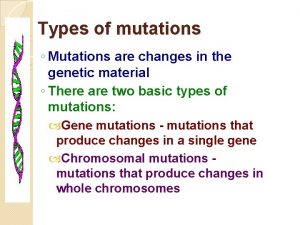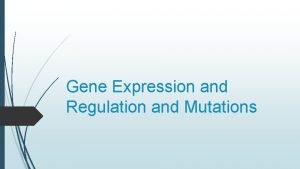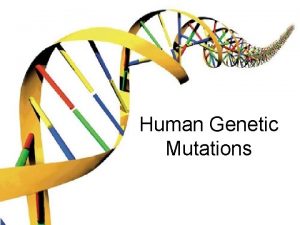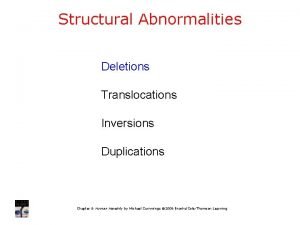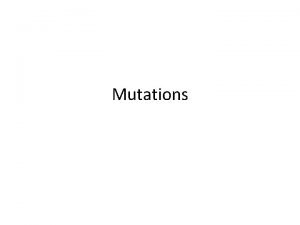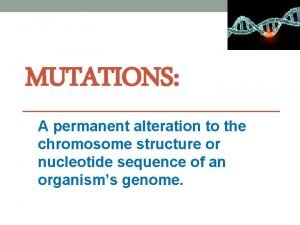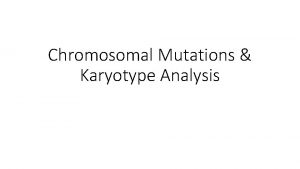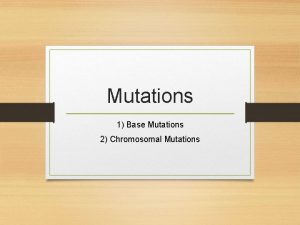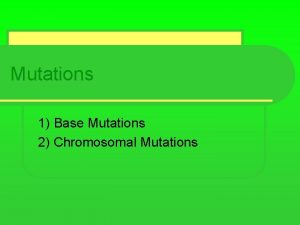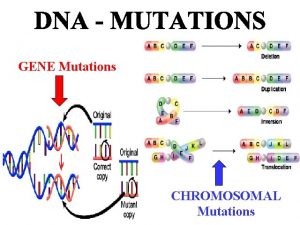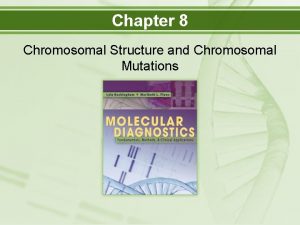GENETIC MUTATIONS Exploring point mutations and chromosomal mutations









- Slides: 9

GENETIC MUTATIONS Exploring point mutations and chromosomal mutations

POINT MUTATIONS A point mutation is when a single nucleotide base is altered. There are 3 types of point mutations: substitutions, insertions, and deletions.

SUBSTITUTIONS A substitution is when one nucleotide base is substituted for another. In the example below, the adenine nucleotide has been replaced with guanine:

INSERTIONS AND DELETIONS An insertion is when a nucleotide is added to the DNA sequence. For example, the code ATTGACGTA might become ATTAGACGTA. A deletion is when a nucleotide is removed from the DNA sequence. For example the code ATTGACGTA might become ATGACGTA.

FRAMESHIFT MUTATION When a substitution occurs, it only affects the codon it is part of. However, insertions and deletions can cause a more severe type of alteration to the code called a frameshift mutation. When a nucleotide is either added or removed, the codons groupings shift, creating an entirely new amino acid sequence.


CHROMOSOMAL MUTATIONS Chromosomal mutations occur when either whole chromosomes or large fragments of chromosomes are added, lost, or moved.

CHROMOSOME FRAGMENTS Sometimes, large fragments of chromosomes can become altered. For example: A chromosome might lose an end fragment or a section from the middle of one of the tails. A fragment of chromosome might get duplicated. A fragment of chromosome might get reversed (inversion). A fragment of chromosome might detatch and reattach to to another chromosome (translocation).

ENTIRE CHROMOSOMES At other times, entire chromosomes can be duplicated or lost. In humans, this can lead to genetic conditions such as: Down Syndrome, or Trisomy 21 (having 3 copies of the 21 st chromosome) Edward Syndrome, or Trisomy 18 (having 3 copies of the 18 th chromosome) Klinefelter Syndrome, or XXY (a male with 2 copies of the X chromosome)
 Syndrome triple x
Syndrome triple x Examples of chromosomal mutations
Examples of chromosomal mutations Point or frameshift mutation
Point or frameshift mutation Duplication chromosomique
Duplication chromosomique Chromosome mutation
Chromosome mutation A permanent alteration that changes a dna sequence
A permanent alteration that changes a dna sequence Gene flow vs genetic drift
Gene flow vs genetic drift Genetic programming vs genetic algorithm
Genetic programming vs genetic algorithm Genetic programming vs genetic algorithm
Genetic programming vs genetic algorithm Genetic drift vs genetic flow
Genetic drift vs genetic flow
